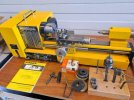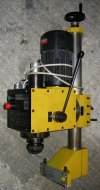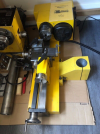You are using an out of date browser. It may not display this or other websites correctly.
You should upgrade or use an alternative browser.
You should upgrade or use an alternative browser.
Lathes and M/C tools.
- Thread starter OzzyO
- Start date
Rob Pulham
Western Thunderer
Will do, I will hopefully start it later today.Hello Rob, all,
please do put a thread on here. When you do drop me a line so I'll know where to look.
ATB
OzzyO.
OzzyO
Western Thunderer
Hello all,
not that much to say at the moment as I'm waiting for materials.
So I've been drawing the mounting plate for the reading head on the Z axis. This is where it will fit, It looks like the scale is out but it's just parallax? error the scale is within one or two Thou over 12".
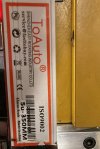
Measuring for the plate it's going to be 3" high and 23/4" wide by 1/4" thick. I'm going to have to remove 5/32" from most of the bottom to account for the step for the ring.
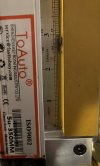
You can see where the step is on the top of the mounting ring. the clamps in place to see where the cover for the scale will fit.
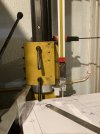
The cover clamped in place.
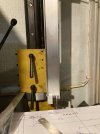
As luck has it there are two M5 holes that just need a tap running through them and I can use them to mark the centres of the M4 holes for the fixing screws.
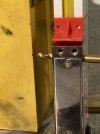
After turning the big aluminium job I decided to get some tips that are for aluminium and non-ferrous metals. These cut the shim tubes absolutely brilliantly.
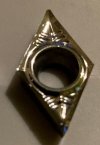
After all the testing for the cover for the Z scale I'm not going to fit it. Just for a bit of fun. Why?
ATB
OzzyO.
not that much to say at the moment as I'm waiting for materials.
So I've been drawing the mounting plate for the reading head on the Z axis. This is where it will fit, It looks like the scale is out but it's just parallax? error the scale is within one or two Thou over 12".

Measuring for the plate it's going to be 3" high and 23/4" wide by 1/4" thick. I'm going to have to remove 5/32" from most of the bottom to account for the step for the ring.

You can see where the step is on the top of the mounting ring. the clamps in place to see where the cover for the scale will fit.

The cover clamped in place.

As luck has it there are two M5 holes that just need a tap running through them and I can use them to mark the centres of the M4 holes for the fixing screws.

After turning the big aluminium job I decided to get some tips that are for aluminium and non-ferrous metals. These cut the shim tubes absolutely brilliantly.

After all the testing for the cover for the Z scale I'm not going to fit it. Just for a bit of fun. Why?
ATB
OzzyO.
OzzyO
Western Thunderer
Hello all,
after I get the DROs fitted to the mill I'm thinking about fitting a stepper motor to the mill a) to decrease the low end speed and b) increase the top end speed. But I'm not sure what I'm going to need. This is the plate on the motor now.
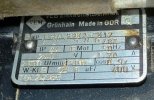
This is the sort of motor I'm thinking about fitting.
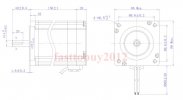
One other thing it will do is reduce the weight that I have to move when the head is going up, on the head going down that is not a problem .
ATB
OzzyO.
after I get the DROs fitted to the mill I'm thinking about fitting a stepper motor to the mill a) to decrease the low end speed and b) increase the top end speed. But I'm not sure what I'm going to need. This is the plate on the motor now.

This is the sort of motor I'm thinking about fitting.

One other thing it will do is reduce the weight that I have to move when the head is going up, on the head going down that is not a problem .
ATB
OzzyO.
Rob Pulham
Western Thunderer
Yours looks a little more complicated to fit than mine was. I am feeling a bit under the weather so I will resume posting when I have more head space.
I note that your mill was made in the GDR, which reminded me of something that I read.
While looking for ideas to make my lathe more rigid. It may of course be an urban myth but I read that all the Chinese mini lathes. Which are sold in the west under various brand names, were originally from a design ripped off from someone/company in the GDR.
I note that your mill was made in the GDR, which reminded me of something that I read.
While looking for ideas to make my lathe more rigid. It may of course be an urban myth but I read that all the Chinese mini lathes. Which are sold in the west under various brand names, were originally from a design ripped off from someone/company in the GDR.
michael080
Western Thunderer
I am not sure this is a stepper motor and I am quite sure you don't want to use one. Typically, they wont't run with more than 100-150rpm in the size range above and unfortunately, stepper motors have almost no torque at full speed. The motor above has only two wires, so I guess it will be a simple DC motor. That is preferable anyway, because you can simply apply a dc-voltage to let it run. Stepper motors need a special voltage pattern on their two coils to rotate.
Michael
Martin Shaw
Western Thunderer
Not a myth at all Rob, all Chinese made mini lathes have their design origins in the Emco Unimat. Emco had the Unimat 4 made in China and inevitably it was copied, initially pretty badly but for a lot less money. The outcome was blatantly obvious, the customer preferred to pay less and accept the lower standards and Emco stopped making hobby machines.
Martin
Martin
I had one of the BFE stand alone milling m/cs but i could not really feel very comfortable with it,the lead screws were RH thread which meant that when you turned the handwheels clockwise,the tables came towards you instead of away from you which is normal engineering practice and the darned thing was metric.I bought it in the 1970s,eventually changed it for a Warco vertical mill some years ago,imperial and normal.
Ray.
Ray.
OzzyO
Western Thunderer
Hello Ray, all,I had one of the BFE stand alone milling m/cs but i could not really feel very comfortable with it, the lead screws were RH thread which meant that when you turned the handwheels clockwise,the tables came towards you instead of away from you which is normal engineering practice and the darned thing was metric. I bought it in the 1970s,eventually changed it for a Warco vertical mill some years ago, imperial and normal.
Ray.
Ray's post got me thinking about the cross slide leadscrew. I've got use to it going the wrong way, but as the M/C is in bits it set me thinking could it be done? At the moment the leadscrew is M14 X 2mm pitch. As I may want to put it back to normal at some time in the future, I don't want to change any of the parts.
So what do I want,
1) new M16 L/H leadscrew Approx. £25.00
2) L/H nuts approx. £7.00
3) Thrust washers approx. £10.00
4) new leadscrew block. To make it. Approx. £10.00
5) new bearing block at the handle end. To make it approx. £15.00
6) new handwheel in stock
7) odds and ends £20.00
All up approx. £100.
The down side is that for making some of the bits I could do with the mill, but if I put the mill back together I won't strip it down again. Striping it down is not a problem but putting it back together is.
Decisions, decisions, decisions.
ATB
OzzyO.
PS is it going to be worth the time and money??????
michael mott
Western Thunderer
An interesting question, the key point is that you mentioned that you have gotten used to it. If you’re in the process of repairing the existing system and you don’t foresee getting a new machine in the future. Perhaps just replacing the existing system would be better rather than changing the system. If however down the road you might want a new system then changing the system would help you when it comes time for a change of machine.
Michael
Michael
Probably not .If you are going to use it much,it would be better to invest in a Warco mill,Warco WM 12 Milling Machine | Small Hobby Bench Mini Mill
I bought a WM 16 some years ago and everything moves in the correct direction.I can`t remember now If it came with a collet chuck (ER25) or whether i bought it separatly.I was one of the first people to buy the BHE mill,i even had CZ instruments asking me how i liked it,i said it was ok but everything worked backwards for me and i would have preferred an imperial model to be offered.This was in the days when small milling m/cs were almost Unavailable.
Ray.
I bought a WM 16 some years ago and everything moves in the correct direction.I can`t remember now If it came with a collet chuck (ER25) or whether i bought it separatly.I was one of the first people to buy the BHE mill,i even had CZ instruments asking me how i liked it,i said it was ok but everything worked backwards for me and i would have preferred an imperial model to be offered.This was in the days when small milling m/cs were almost Unavailable.
Ray.
John Hutnick
New Member
Just as a matter of general interest, I have a Taig milling machine. The leadscrews turn in the normal direction. They use a leadscrew that is 1/2-20, which I find convenient since I am more frequently working in inches.
OzzyO
Western Thunderer
Hello all,
thanks for the input Ray, I've had a look at one of the Warco mills the WM14 series and I would not gain that much it's table is 550 X 140mm my Hobby mat's table is 450 X 160mm. So getting one of the Warco 14s I would gain 100mm on the length and loose 20mm on the width. but getting one of the 12s I would loose 50mm on the length and 40mm on the width. So do I put out approx. £1000 for a M/C that I may not like using? I'm used to having to change how mills are laid out as I've worked on M/Cs from a 3 foot table to a 10 foot table. Some were right bags of they all had one thing in common all of them had index wheels, some were imperial some were metric and one or two had converter dials, that was good.
they all had one thing in common all of them had index wheels, some were imperial some were metric and one or two had converter dials, that was good.
The other thing is I could spend the £1000 on approx. two locos.
John, I get the 1/2 as 1/2" dia. but the 20 is that 20 tpi that would give you .050" per rev. or some thing else.
ATB
OzzyO.
PS. leadscrew, nuts and thrust washers ordered, that was less than £35.00 all the other bits I have in stock.
thanks for the input Ray, I've had a look at one of the Warco mills the WM14 series and I would not gain that much it's table is 550 X 140mm my Hobby mat's table is 450 X 160mm. So getting one of the Warco 14s I would gain 100mm on the length and loose 20mm on the width. but getting one of the 12s I would loose 50mm on the length and 40mm on the width. So do I put out approx. £1000 for a M/C that I may not like using? I'm used to having to change how mills are laid out as I've worked on M/Cs from a 3 foot table to a 10 foot table. Some were right bags of
 they all had one thing in common all of them had index wheels, some were imperial some were metric and one or two had converter dials, that was good.
they all had one thing in common all of them had index wheels, some were imperial some were metric and one or two had converter dials, that was good.The other thing is I could spend the £1000 on approx. two locos.
John, I get the 1/2 as 1/2" dia. but the 20 is that 20 tpi that would give you .050" per rev. or some thing else.
ATB
OzzyO.
PS. leadscrew, nuts and thrust washers ordered, that was less than £35.00 all the other bits I have in stock.
Last edited:
Rob Pulham
Western Thunderer
I guess you are going for it after all. In your place I would have done the same.PS. leadscrew, nuts and thrust washers ordered, that was less than £35.00 allthe other bits I have in stock.
I machined all the axle boxes which have seperate keeps so that by knocking out two pins,i could drop the bottom of the box and take the axle out on my BFE65 but it was quite tricky as the drawings were imperial.I replaced it with my WM16 as it wasn`t really up to milling the coupling rods.Hello all,
thanks for the input Ray, I've had a look at one of the Warco mills the WM14 series and I would not gain that much it's table is 550 X 140mm my Hobby mat's table is 450 X 160mm. So getting one of the Warco 14s I would gain 50mm on the length and loose 20mm on the width. but getting one of the 12s I would loose 50mm on the length and 40mm on the width. So do I put out approx. £1000 for a M/C that I may not like using? I'm used to having to change how mills are laid out as I've worked on M/Cs from a 3 foot table to a 10 foot table. Some were right bags ofthey all had one thing in common all of them had index wheels, some were imperial some were metric and one or two had converter dials, that was good.
The other thing is I could spend the £1000 on approx. two locos.
John, I get the 1/2 as 1/2" dia. but the 20 is that 20 tpi that would give you .050" per rev. or some thing else.
ATB
OzzyO.
PS. leadscrew, nuts and thrust washers ordered, that was less than £35.00 allthe other bits I have in stock.
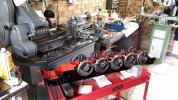
Last edited:
OzzyO
Western Thunderer
Hello Ray,
nothing tricky about doing an imperial job on a metric M/C or a metric job on an imperial M/C 1" equals 25.4mm. The same as 19mm equals 0.74803". The same as 3/4" 19.05mm.
All you need is to divide the metric number by 25.4, So 12.7mm divided 25.4mm = 1/2", so if you want to convert 11/2" to metric just multiply by 25.4 = 38.1mm.
25.4 is your magic number.
ATB
OzzyO.
nothing tricky about doing an imperial job on a metric M/C or a metric job on an imperial M/C 1" equals 25.4mm. The same as 19mm equals 0.74803". The same as 3/4" 19.05mm.
All you need is to divide the metric number by 25.4, So 12.7mm divided 25.4mm = 1/2", so if you want to convert 11/2" to metric just multiply by 25.4 = 38.1mm.
25.4 is your magic number.
ATB
OzzyO.
It was its nasty habit of the tables going in the wrong direction when all my other machine tools had LH threads.I had to keep my wits about me when milling 10 axle boxes and keeps.Hello Ray,
nothing tricky about doing an imperial job on a metric M/C or a metric job on an imperial M/C 1" equals 25.4mm. The same as 19mm equals 0.74803". The same as 3/4" 19.05mm.
All you need is to divide the metric number by 25.4, So 12.7mm divided 25.4mm = 1/2", so if you want to convert 11/2" to metric just multiply by 25.4 = 38.1mm.
25.4 is your magic number.
ATB
OzzyO.
Ray.

